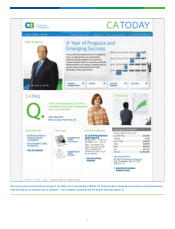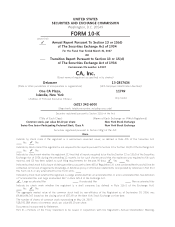Computer Associates 2007 Annual Report Download - page 19
Download and view the complete annual report
Please find page 19 of the 2007 Computer Associates annual report below. You can navigate through the pages in the report by either clicking on the pages listed below, or by using the keyword search tool below to find specific information within the annual report.Our Capability Solutions include:
•CA Identity & Access Management — Automates the management of a user’s identity through its life cycle, ensuring that
only authorized users can access critical ITresources from the Web to the mainframe. Mitigates risk, supports compliance
initiatives and enables new business opportunities.
•CA Security Information Management — Provides centralized management of real-time events and post-event forensics
analysis to improve administrator efficiency and reduce costs while ensuring security.
•CA Threat Management — Prevents spyware, viruses, worms, spam and malicious content from infiltrating and infecting a
customer’s network, email and business applications. Identifies threats and infrastructure vulnerabilities, preventing
incidents before they negatively impact assets.
In the past year, CA has brought new security products to market (such as CA Host-based Intrusion Prevention), has grown in
new market segments (extending the security portfolio in the consumer and mid-markets) and has updated the main product
suites and expanded into new areas around Federated, SOA security and embedded application security. Going forward, we
will continue to focus on initiatives regarding ease-of-use, improvement in product quality, innovation and leadership in
security markets.
Our Unified Service Model and Integration Platform
With the EITM vision and CA Capability Solutions, our EITM architecture enables high-quality services to be delivered to
users, while optimizing assets and resources. The Unified Service Model, maintained in the CA Configuration Management
Database (CA CMDB), is the centerpiece of our architecture for delivering EITM. As mentioned earlier, the Unified Service
Model provides a complete 360-degree view into the IT services delivered to the business. The Unified Service Model
incorporates all information that defines the characteristics of a service. This includes asset and relationship details, service
levels, prices, costs, quality, risks and exposures and consumer information. The Unified Service Model is central to
maintaining a common view of IT across all disciplines, enabling more coordinated automation, ensuring IT is meeting
the needs of the business and helping customers create greater value. Instead of spending time and resources on manually
handling routine maintenance and day-to-day IT issues, customers can free up time and budget to pursue initiatives more
strategic to the business.
Through the Unified Service Model, our EITM architecture can provide critical insights on specific areas of the business so that
customers can take the appropriate action in the following ways:
•Service Impact — Through the Unified Service Model, customers can manage ITservices to ensure they are directly in line
with business priorities. They can prioritize the most business-critical services over less important ones so their service
quality is never compromised and resolve incidents and problems that impact those services more quickly.
•Assets and Resources — Because the Unified Service Model provides insight into the relationships and interdependencies
between IT assets and the services they support, it can help customers make the most efficient use of their assets and
resources.
•Identity — Integration with our security solutions enables our customers to manage the identity and entitlements of users
from a services perspective. In other words, customers can ensure that any technology asset or IT staffer involved in
supporting a given service and any users of the service have the appropriate, secure access they require.
•Service Portfolio — A Service Portfolio leverages the Unified Service Model to provide insight into the consumption, quality,
costs and risks associated with those services to guide investment decisions.
The CA Integration Platform is the architectural foundation upon which our products are integrated. The CA Integration
Platform leverages a SOA to deliver a set of shared, modular services, including an integrated workflow, User Interface services
and scheduling services.
7
























